1.During the process of our study, we integrated our study with Grade 1-9 Consistent Curriculum as follows:
| Curriculum |
Our Study, Integrative Activity |
| Language and Arts |
After each event and interview, we wrote down our work content and reflections, sorted study information, practiced interview skills and distributed questionnaires. Thus, our planning, conceiving, expressing, reading and writing abilities were enhanced.
|
| Mathematics |
We calculated the necessary cost for the implementation of the study. We planned events under the circumstance of limited money. We analyzed questionnaires, gathered statistics, and presented the results by charts.
|
| Integrative Activity |
We obtained social resources, visited and interviewed people with proper manners, and built up the ability of integration.
|
| Science and Technology |
Through Internet searching, using digital cameras and making the post-production, using a computer mind map, and creating our team blog and web pages, we explored related issues and presented our study results. We also cultivated the ability to use technology and information in our daily life.
|
| Social Studies |
Through the study, we cooperated as a team, did work individually, and learned to coordinate. We further observed and documented our community environment. Eventually, we learned the dependences between people and the environment. We appreciate and care about everything, and would like to further our appreciation and put our knowledge to work.
|
| Arts and Humanities |
We tried to use various materials for completing the yurts. We designed logos, pins, e-books, cards, and gift packaging. Our rich imagination was triggered. We enjoyed the pleasure of creation.
|
| Health and Physical Education |
We are able to use our physical strengths to make field investigation and engage in proper exercises. We also develop a healthy attitude towards our life. |
2.Information tools and technologies we used to complete our Cyberfair Project:
| Types |
Tools |
Usage |
| Hardware |
Digital Camera |
taking photos |
| Pen Digital Voice Recorder |
recording interview content |
| Scanner |
processing image |
| Printer |
printing relevant data |
| Computer |
editing information |
| Internet Explorer |
searching for information, communicating, sending and downloading files |
| Digital Video Camera |
recording activities |
| Telephone and Cell Phone |
communication |
| Software |
Word |
editing documents |
| Excel |
analyzing questionnaire |
| PowerPoint |
making briefing pages |
| nEO iMAGING |
compressing image files, editing photo |
| Print Magic |
producing posters |
| Flash, Dreamweaver |
designing web pages |
| Ulead Video Studio |
editing films |
| Photoimpact |
editing photos |
3.Roles
Q:How does your research change your community?
1.We made efforts to acquire community resources. We also raised residents’ awareness of environmental issues, leading them to realize the importance of protecting the environment and recycling.
2.Based on the results of our questionnaires, we made a proposal and submitted suggestions to relevant organizations.
3.We are dedicated to promoting recycling, and we hope Ling Jhou students and the community residents cherish and frequently use the yurts that we restored together.
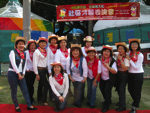
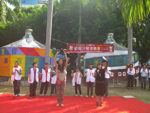
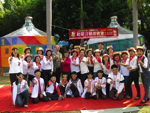
Q:What distinguished you from the others?
1.We conducted interview with executives of some department stores and successfully got their support. They donated a lot of recyclable resources to our school.
2. We sent a proposal according to opinions related to our research to Mayor Chen’s mailbox and got a response.
3.We acquired recognition from media, such as Kaohsiung Education Bureau website, Taiwan Times, United Daily News Network, CNA News, and National Education Radio Station, etc. They have reported our project.
4.We practiced what we preached. We let our community and school work together to restore the yurts and turned trash into gold. We also raised the community residents’ awareness of environmental protection. We served as an example for environmental issues.
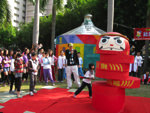
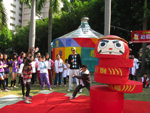

Q: Did you make new local connections?
1. We got encouragement and affirmation from Dream Mall, FE21’ MegA, New Century, Cheng-si Neighborhood, Kaohsiung Community Education Association, and the Director of Kaohsiung Education Bureau, Mr. Shin-hui Cheng. They expected us to be aspirant, to set a example for others, and to share our experiences and reflections to our classmates and our community.
2.Through our study results, we conveyed our community residents’ opinions to the relevant government agencies. Thus, we act as a bridge between people and the government.
3.The restored yurts were rebuilt with donations from organizations in our community. The yurts connected those organizations and our school. We think the friendship and connection between us will last forever.
4.Impact
Cognition
1. We learned that the image of the department store is very important and the recycled resources are hundreds of tons which are collected by private waste collection companies.
2. We recognized that environmental protection is a pressing task and it is every Earth citizen’s responsibility.
3. We found that “doing” is more difficult than “thinking.” Implementing the concept of environmental protection is hard.
4. Using cartons to make props is more difficult than expected, but as long as we keep trying, cartons can be made into beautiful and functional appliances.
5. The Kyoto Protocol, discussed at Doha Climate Change Conference in December 2012 is the only international agreement that constrains global greenhouse gas emissions into the atmosphere. After it expired on December 31, 2012, in order to achieve the emission reduction constraints and to curb climate change, the second commitment period of the Kyoto Protocol was adopted.
Affection
1. We were inspired by the great spirit of our interviewees. Despite their busy schedule, they dedicated their time and money to support our school and community. They also devoted their time to issues such as environmental protection and education. They set a good example for us.
2. Every member in our team is important and indispensable. During the period of restoring the yurts, we were supported and encouraged by our community and school. We received community resources and the assistance of our teachers, school students, janitors, and parents.
Skills
1. We learned effective questionnaire implementation, statistics, and chart presentation.
2. We learned qualitative interviewing skills, information summary, and analysis.
3. We learned how to submit opinions to government organizations, how to speak out for the public, and how to benefit the community.
4. We learned how to act as competent community ambassadors to promote the interests of our community.
5. We cultivated our communication, coordination, organization, and integration abilities.
6. We learned how to do case studies and how to make web pages.
5.Copyright
Our webpage design, the pictures we used, and the contents were conceived and created by each member of our team individually. Some old photos are from the 100th anniversary commemorative album of Ling Jhou Primary School and we cited their origins on our web pages. All rights reserved to our team.
6.Discovery, Lessons, and Surprises
After more than four months of hard work, we realized:
1. The Kyoto Protocol discussed at Doha Climate Change Conference in December, 2012 is the only international agreement that constrains global green house gas emissions in the atmosphere. After it expired on December 31, 2012, in order to achieve the emission reduction constraints and to curb climate change, the second commitment period of the Kyoto Protocol has adopted. It is extended to the end of 2020. It is obvious that the reduction of carbon emissions is still an important issue for the world’s citizens.
2. We learned skills related to interview, inquiry, and summary.
3. Through our teamwork, we learned to gather, clean, design, and reuse the recycled materials. Gradually, we restored the yurts and turned trash into gold.



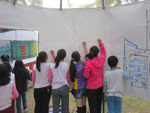
4. We tried to visit and talk to strangers. In addition, we designed leaves in the shape of Taiwan. We awoke people’s awareness on environmental protection and asked them to write down their wishes or blessings to the Earth.
5. We held an opening ceremony for the restored yurts where everyone enjoyed a joyful afternoon on the grass. At the same time, our community residents, teachers, and students witnessed the outcome of our efforts.
6. We conducted a survey on the community residents’ satisfaction at their surroundings. Then we submitted the result to government agencies for their reference to guide future promotion and improvement efforts.



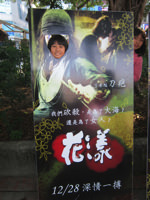














 Information
Information 
